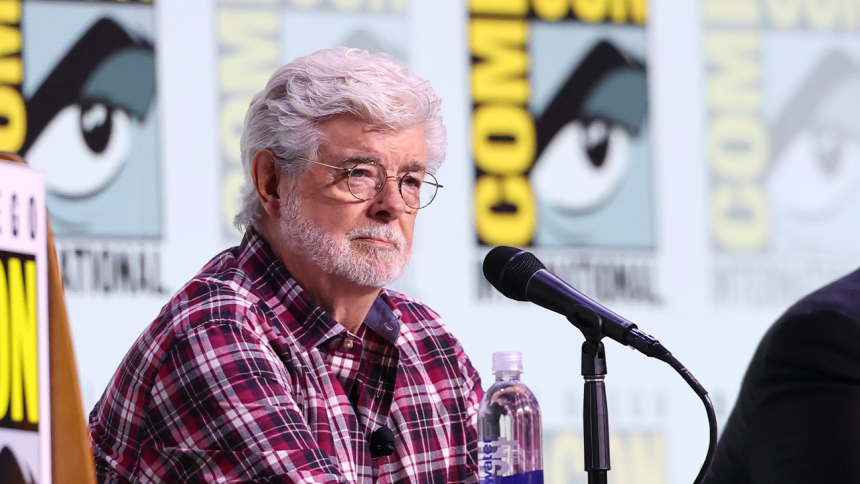George Lucas Makes Comic-Con Debut, Unveils First Look at His “Temple to the People’s Art” Museum
George Lucas stepped into the San Diego Convention Center’s cavernous Hall H and stepped into history, as the legendary creator of Star Wars made his first ever appearance at Comic-Con, the popular arts convention that has partially been built off his stories and creations.
It was the largest ever Sunday panel for the convention, according to sources, which usually sees its marquee presentation headline on Friday or Saturday. But such is the power of Lucas.
Thousands waited hours just to get inside, chanted “Lu-cas, Lu-cas!” while they waited, and then gave a wild standing ovation as the filmmaker took to the stage, introduced by rapper-actress Queen Latifah, and sat down next to filmmaker Guillermo del Toro and Star Wars production designer Doug Chiang.
If the 6,500-strong crowd was disappointed he didn’t talk a whiff about Star Wars or Indiana Jones, it wasn’t shown, as cries of “I love you, George!” and waving lightsabers punctuated the air several times.
You Might Also Like
Lucas even received a standing ovation when he left the presentation, which was devoted entirely to the Lucas Museum of Narrative Art. He, along with museum board member and fellow art collector del Toro and Chiang, were there to not only give a first look at the museum but also make a case for the importance and validity of narrative art, which includes comic book art, as a vital form of expression.
“This is a temple to the people’s art,” Lucas said, speaking about the idea for his museum. His first words in Hall H were about how he began acquiring art while in college, but all he could afford was comic book art. With success, he expanded his art collection to now over 40,000 pieces.
“What is important to me, what is magical, is not a man and his collection, it’s a lineage of images,” explained del Toro. “We are in a critical moment in which one thing they like to disappear is the past.”
“And this is memorializing a popular, vociferous and eloquent moment in our visual past that belongs to all of us. And the museum celebrates this,” he added.
A video presentation showed interior looks at the museum — there are no right angles anywhere, Latifah underscored — as well as images that will be in the collection.
A cover of DC comic Mystery in Space, featuring the first appearance of Adam Strange; the first ever Flash Gordon comic strip; a cover of 1950s EC comic Tales from the Crypt; strips of Peanuts and Garfield; art ranging from Brian Bolland and Hellboy creator Mike Mignola to underground cartoonist Robert Crumb, Windsor McKay and Moebius; art of Astro Boy and Scrooge McDuck. But there were also images of art by Norman Rockwell, N.C. Wyeth and Frieda Kahlo.
Also in the museum will be concept and storyboard art from Star Wars and Raiders of the Lost Ark by Ralph McQuarrie and Jim Steranko, as well as the props of starships and speeders from various Star Wars movies.
Chiang explained that comic art in particular had long been discounted. “It’s not taken seriously,” he said, and when he was younger was told, “You will outgrow it one day.”
“I’m so glad I didn’t,” he said, before driving home the point that one of the strengths of narrative art is that it’s driven by story. “Story comes first. Art comes second.”
The idea of narrative art being a driver of community and common belief systems was one to which Lucas, in sometimes elliptical ways, kept repeating and returning.
Del Toro also got into the heady and philosophical, denoting differences between art for myth-building purposes and art for propaganda purposes
“Myth belongs to all of us, propaganda belongs to a very small group,” he said. “Myth unites us, propaganda divides us.”
The museum, which has had its opening pushed back several times, is slated to open in 2026.







